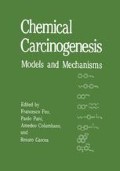Abstract
It is becoming well established that the development of hepatocellular carcinoma in the liver of the rat occurs through a number of steps (8 to 10 or more), some of which involve changes in a rare cell and others the progressive modulation of the phenotype in new hepatocyte populations1. Two major sequences appear in the majority of the models of liver carcinogenesis1,2. Sequence A, consisting of initiation and promotion, generates benign focal proliferations of hepatocytes (“clonal nodules”), a very small proportion (1–5%) of which persist2. Sequence B, consisting of progression, is the multistep process whereby the first precancerous lesion, the persistent hepatocyte nodule, slowly undergoes a series of changes leading to cancer. This sequence also includes the changes that occur in a bona fide cancer leading to increasing growth, invasion and metastasis2. Clearly, sequence B is the most relevant and most critical in the development of cancer. It can occur “spontaneously” and needs no external manipulation and is often not influenced in a major way by promoting environments.
Access this chapter
Tax calculation will be finalised at checkout
Purchases are for personal use only
Preview
Unable to display preview. Download preview PDF.
References
E. Farber and D. S. R. Sarma, Biology of Disease: Hepatocarcinogenesis: a dynamic cellular perspective, Lab. Invest. 56:4 (1987).
E. Farber, Some emerging general principles in the pathogenesis of hepatocellular carcinoma, Cancer Surveys 5:695 (1986).
E. Farber, Cellular biochemistry of the stepwise development of cancer with chemicals: G.H.A. Clowes Memorial Lecture, Cancer Res. 44:5463 (1984).
J. Rotstein, P. D. M. Macdonald, H. M. Rabes and E. Farber, Cell cycle kinetics of rat hepatocytes in early putative preneoplastic lesions in hepatocarcinogenesis, Cancer Res. 44:2913 (1984).
J. Rotstein, D. S. R. Sarma and E. Farber, Sequential alterations in growth control and cell dynamics of rat hepatocytes in early precancerous steps in hepatocarcinogenesis, Cancer Res. 46:2377 (1986).
M. Tatematsu, G. Lee, M. A. Hayes and E. Farber, Progression of hepatocarcinogenesis: differences in growth and behaviour of transplants of early and late hepatocyte nodules in the spleen, Cancer Res. 47:4699 (1987).
K. Enomoto and E. Farber, Kinetics of phenotypic maturation of remodeling of hyperplastic nodules during liver carcinogenesis, Cancer Res. 42:2330 (1982).
M. Tatematsu, Y. Nagamine and E. Farber, Redifferentiation as a basis for remodeling of carcinogen-induced hepatocyte nodules to normalappearing liver, Cancer Res. 43:5049 (1983).
R. Schulte-Hermann, Adaptive liver growth induced by xenobiotic compounds and other stimuli, Crit. Rev. Toxicol. 3:97 (1974).
R. Schulte-Hermann, Reactions of the liver to injury: adaptation, in: “Toxic Injury of the Liver”, E. Farber and M. M. Fisher, eds., Marcel Dekker, New York (1979).
N. Bohm and B. Moser, Reversible hyperplasia and hypertrophy of the mouse liver induced by a functional charge with phenobarbital, Beitr. Pathol. 157:283 (1976).
W. G. Levine, M. G. Ord and L. A. Stocken, Some biochemical changes associated with nafenopin-induced liver growth in the rat, Biochem. Pharmacol. 26:939 (1977).
R. Schulte-Hermann, V. Hoffman, W. Parzefall, M. Kallenbach, A. Gerhard and J. Schuppler, Adaptive responses of rat liver to the gestagen and anti-androgen cyproterone acetate and other inducers, II, Induction of growth, Chem. Biol. Interact. 31:287 (1980).
A. Columbano, G. M. Ledda, P. Sirigu, T. Perra and P. Pani, Liver cell proliferation induced by a single dose of lead nitrate, Am. J. Pathol. 110:83 (1983).
W. Bursch, B. Lauer, I. Timmermann-Trosiener, G. Barthel, J. Schuppler and R. Schulte-Hermann, Controlled death (apoptosis) of normal and putative preneoplastic cells in rat liver following withdrawal of tumor promoters, Carcinogenesis 5:453 (1984).
A. Columbano, G. M. Ledda-Columbano, P. P. Coni, G. Faa, C. Liguori, G. Santa Cruz and P. Pani, Occurrence of cell death (apoptosis) during the involution of liver hyperplasia, Lab. Invest. 52:670 (1985).
A. Columbano, G. M. Ledda-Columbano, P. M. Rao, S. Rajalakshmi and D. S. R. Sarma, Occurrence of cell death (apoptosis) in preneoplastic and neoplastic liver cells, Am. J. Pathol. 116:441 (1984).
D. Solt and E. Farber, New principle for the analysis of chemical carcinogenesis, Nature (Lond) 268:702 (1976).
H. Tsuda, G. Lee and E. Farber, Induction of resistant hepatocytes as a new principle for the possible short-term in vivo test for carcinogens, Cancer Res. 40:1157 (1980).
E. Farber, Resistance phenotype in the initiation and promotion of chemical hepatocarcinogenesis, Chemica Scripta 27A:131 (1987).
D. B. Solt, A. Medline, and E. Farber, Rapid emergence of carcinogeninduced hyperplastic lesions in a new model for the sequential analysis of liver carcinogenesis, Am. J. Pathol. 88:595 (1977).
A. Columbano, G. M. Ledda-Columbano, G. Lee, S. Rajalakshmi, and D. S. R. Sarma, Inability of mitogen-induced liver hyperplasia to support the induction of enzyme-altered islands induced by liver carcinogens Cancer Res. 47:5557 (1987).
R. Schulte-Hermann, I. Timmermann-Trosiener, and J. Schuppler, Response of liver foci in rats to hepatic tumor promoters, Toxicol. Pathol. 10:63 (1982).
H. Popper, S. S. Sternberg, B. C. Oser, and M. Oser, The carcinogenic effect of aramite in rats. A study of hepatic nodules, Cancer(Phila) 13:1035 (1960).
Author information
Authors and Affiliations
Editor information
Editors and Affiliations
Rights and permissions
Copyright information
© 1988 Springer Science+Business Media New York
About this chapter
Cite this chapter
Ferber, E., Rotstein, J., Harris, L., Lee, G., Chen, ZY. (1988). Cell Proliferation and Cell Loss in Progression in Liver Carcinogenesis: A New Hypothesis. In: Feo, F., Pani, P., Columbano, A., Garcea, R. (eds) Chemical Carcinogenesis. Springer, Boston, MA. https://doi.org/10.1007/978-1-4757-9640-7_18
Download citation
DOI: https://doi.org/10.1007/978-1-4757-9640-7_18
Publisher Name: Springer, Boston, MA
Print ISBN: 978-1-4757-9642-1
Online ISBN: 978-1-4757-9640-7
eBook Packages: Springer Book Archive

